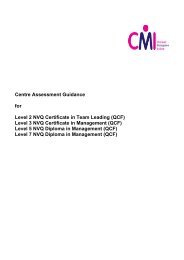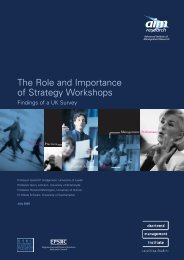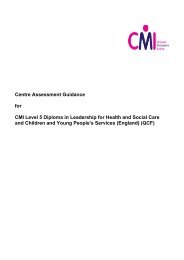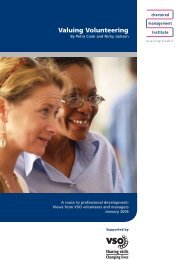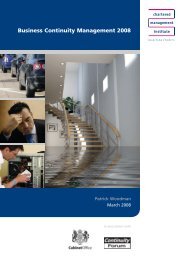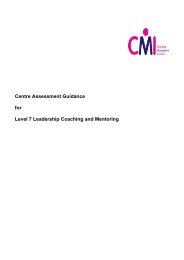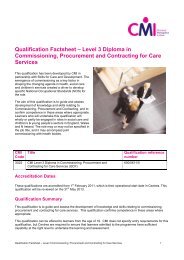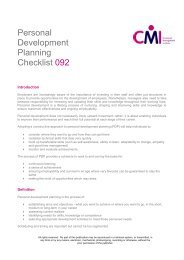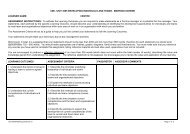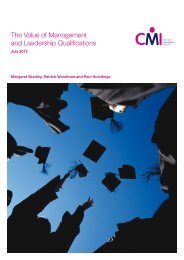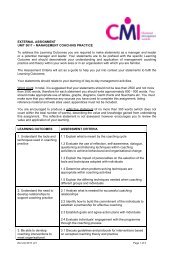Centre Assessment Guidance for CMI Level 3 Diploma in ...
Centre Assessment Guidance for CMI Level 3 Diploma in ...
Centre Assessment Guidance for CMI Level 3 Diploma in ...
You also want an ePaper? Increase the reach of your titles
YUMPU automatically turns print PDFs into web optimized ePapers that Google loves.
<strong>Level</strong> 3 <strong>Diploma</strong> <strong>in</strong> Commission<strong>in</strong>g, Procurement and Contract<strong>in</strong>g <strong>Centre</strong> <strong>Assessment</strong> <strong>Guidance</strong>Title:Understand the context of support<strong>in</strong>g <strong>in</strong>dividuals with learn<strong>in</strong>gdisabilities<strong>Level</strong>: 2 Unit Number: LD 201 QCA UnitNumber:K/601/5315Credit value: 4 Guided Learn<strong>in</strong>gHours35Learn<strong>in</strong>g outcomes<strong>Assessment</strong> criteriaThe learner will:1. Understand the legislation and policiesthat support the human rights and <strong>in</strong>clusionof <strong>in</strong>dividuals with learn<strong>in</strong>g disabilitiesThe learner can:1.1 Identify legislation and policies that aredesigned to promote the human rights,<strong>in</strong>clusion, equal life chances and citizenship of<strong>in</strong>dividuals with learn<strong>in</strong>g disabilities1.2 Expla<strong>in</strong> how this legislation and policies<strong>in</strong>fluence the day to day experiences of<strong>in</strong>dividuals with learn<strong>in</strong>g disabilities and theirfamilies2. Understand the nature andcharacteristics of learn<strong>in</strong>g disability2.1 Expla<strong>in</strong> what is meant by ‘learn<strong>in</strong>gdisability’2.2 Give examples of causes of learn<strong>in</strong>gdisabilities2.3 Describe the medical and social models ofdisability2.4 State the approximate proportion of<strong>in</strong>dividuals with a learn<strong>in</strong>g disability <strong>for</strong> whomthe cause is ‘not known’2.5 Describe the possible impact on a family ofhav<strong>in</strong>g a member with a learn<strong>in</strong>g disability3. Understand the historical context oflearn<strong>in</strong>g disability3.1 Expla<strong>in</strong> the types of services that havebeen provided <strong>for</strong> <strong>in</strong>dividuals with learn<strong>in</strong>gdisabilities over time3.2 Describe how past ways of work<strong>in</strong>g mayaffect present services3.3 Identify some of the key changes <strong>in</strong> thefollow<strong>in</strong>g areas of the lives of <strong>in</strong>dividuals whohave learn<strong>in</strong>g disabilities:• where people live• daytime activities• employment• sexual relationships and parenthood• the provision of healthcare4. Understand the basic pr<strong>in</strong>ciples andpractice of advocacy, empowerment and4.1 Expla<strong>in</strong> the mean<strong>in</strong>g of the term ‘social<strong>in</strong>clusion’Version 1 – Feb 11 Page 46 of 73



